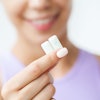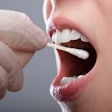
It all began when one of my daughters, who was 6 years old at the time, asked, "What's that clicking noise?"
As someone who has been in the dental field for 20 years now (10 years when this question was posed), I feel quite knowledgeable about dental conditions, symptoms, prevention, etc. And, like every mother, I did my best to protect my children from getting sick and/or being in pain. However, this was a baffling and challenging occurrence.
 Lacy Walker, RDH, CDA.
Lacy Walker, RDH, CDA.It was the winter of 2009. I was in hygiene school. One day, when I went to the daycare facility that was literally attached to the dental hygiene building, I found my little girl curled up in a corner asleep. When she awoke, she complained of an earache and a fever, which wouldn't be uncommon during the winter months. She had earaches in the past. However, this one was different as it was more painful than she had previously experienced.
This painful earache led to the usual/typical doctor appointments and pharmaceutical visits to determine treatment. After the infection and pain were addressed and subsided, a new symptom appeared: She complained of a "clicking noise" that she could hear all the time. It didn't go away. There was clicking all ... day ... long.
Intrigued and confused, I turned off all noise-emitting electronics. We sat in "silence" in the room, but I was able to hear a faint clicking sound. I searched for the source of this clicking and finally realized the noise was coming from her ears! I put my ear up to hers and noticed something else -- the rhythm sounded similar to a heartbeat! Finally, after visiting numerous specialists, including a pediatric cardiologist, an audiologist, and two otolaryngologists and having echocardiogram and audiometry tests performed, the diagnosis came in. It was palatal myoclonus.
Huh? What's that? I have asked a number of colleagues of mine who are dentists and hygienists about it. Not one of them is familiar with this condition.
Palatal myoclonus is defined as a rhythmic, involuntary, jerking movement of the soft palate and pharyngopalatine arch, often involving the diaphragm and laryngeal muscles, according to Kim et al in Stroke (Elsevier, 2015).
The repetitive contractions of the soft palate occur in the range of 60 to 180 per minute, according to additional research. This is a rare condition, and the etiology is unknown. Research suggests that it often occurs after a stroke. Thankfully, I have been reassured this was not the case with my daughter.
She's 16 now. She still experiences the audible clicking. If you were to look in the back of her throat, you can see the involuntary rhythmic contraction occurring.
The questions are "Will it ever go away?" and "Are there treatment options?" Respectively answered, no one knows and yes there are treatments. However, she has chosen to live and deal with these involuntary muscular contractions and the clicking sounds. Why? She considered the treatment options that are available, including surgical intervention, botulinum toxin (Botox) injection, pharmaceutical therapy, or just "do nothing." Since some of these options have unappealing side effects, such as possible speech impairments and dysphagia, she chose the "do nothing" option and deals with the clicking. Unfortunately, there is insufficient information as to the exact pathophysiology of this rare condition, so better treatment options do not yet exist.
The good news is that, even after many years of now living with this rare condition, it has not affected her ability to excel in education or extracurricular activities. She received the highest GPA in middle school, was captain of the soccer team, and currently has a 4.0 GPA in high school!
Lacy Walker, RDH, CDA, CPFDA, practices hygiene full time in North Carolina. She is also the podcast continuing education director for A Tale of Two Hygienists. She can be reached by email at [email protected].
The comments and observations expressed herein do not necessarily reflect the opinions of DrBicuspid.com, nor should they be construed as an endorsement or admonishment of any particular idea, vendor, or organization.



















